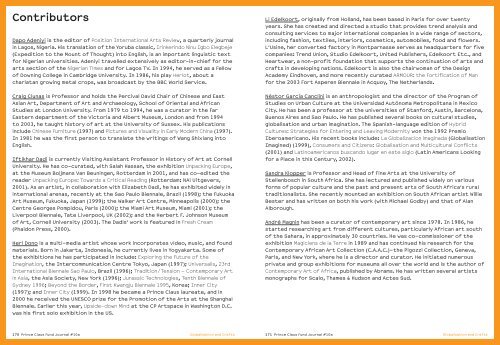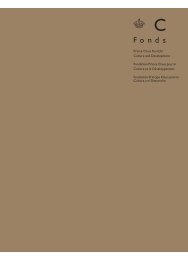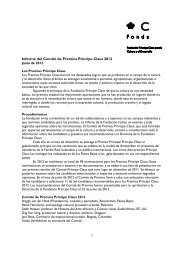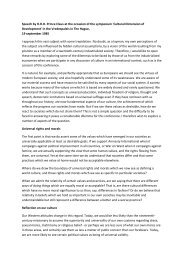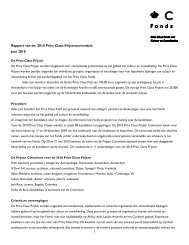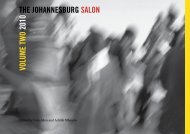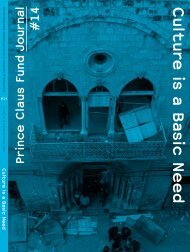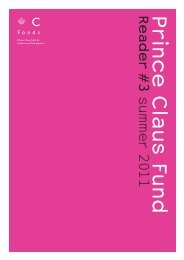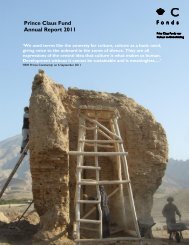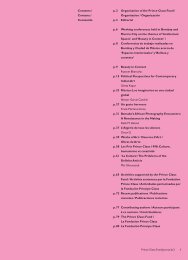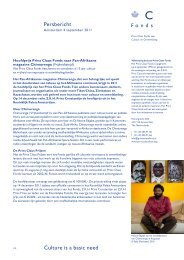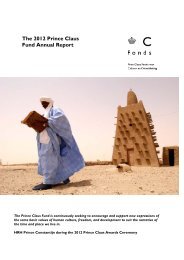Here - Prince Claus Fund
Here - Prince Claus Fund
Here - Prince Claus Fund
Create successful ePaper yourself
Turn your PDF publications into a flip-book with our unique Google optimized e-Paper software.
from prison of Nelson Mandela and others in the early 1990s, a range of nationbuilding<br />
projects has encouraged the emergence of new, more inclusive cultural<br />
identities. On the other hand, local identities have also become increasingly<br />
fragmented and more individualised. For this reason, the contemporary South<br />
African situation evokes comparison with Appiah’s description of the postmodern/post-colonial<br />
African polyglot whom outsiders refer to as ‘Yoruba’ –<br />
thereby affirming their own clichéd assumptions about cultural identity – but who<br />
no longer regards this ethnic designation as relevant to his understanding of<br />
himself. 6<br />
In South Africa, little, if any, attempt has thus far been made to address the<br />
implications of this refusal to embrace ethnicity as a primary frame of selfreference.<br />
Nor has any concerted attempt been made to explore the possible<br />
role of individual aesthetic choice in the production of long-established art<br />
forms like beadwork, presumably because artistic traditions like these still seem<br />
to validate the idea that both the producers and the consumers of these craft<br />
forms celebrate ethnicity through style: even in post-apartheid South Africa,<br />
most local beadwork styles are still readily identifiable as ‘Xhosa’, or ‘Zulu’, or<br />
‘Sotho’. This evidence notwithstanding, the impact globalisation and the<br />
democratisation of South African society have had on local social relations is far<br />
greater than it might appear at first sight. Even in some outlying rural areas,<br />
ethnicity has become ‘conspicuously devoid of solid cultural content’. 7 In keeping<br />
with recent observations regarding contemporary social networks in the US, it<br />
would in fact seem that, in many cases, South Africa’s ethnic communities are<br />
separated from one another by the same culture.<br />
Using this idea of cultural ‘sameness’ as a point of departure, the present<br />
discussion focuses on a number of beadwork and other garments produced in the<br />
course of the 1990s for use on special or ritual occasions. Some of these pieces,<br />
which are associated with initiation practices in present-day Limpopo Province,<br />
close to South Africa’s border with Zimbabwe, are worn by girls. (figs. 1, 2 and 3).<br />
Others, known as imithika, were collected in the Debe Nek and King Williamstown<br />
districts in the Eastern Cape (figs. 5, 6, 7, 8). Although acquired from diviners who<br />
dress in garments like these during their consultations with clients, in rural<br />
Xhosa-speaking areas and in Cape Town’s historically black satellite<br />
neighbourhoods like Langa and Khayelitsha, imithika are also worn by young male<br />
initiates prior to leaving their homes for initiation lodges.<br />
These beadwork garments and ‘skirts’ are all characterised by an<br />
extraordinarily abundant incorporation of discarded plastic trinkets, broken<br />
watches (fig. 1), small action toys (figs. 3, 4), birdcage mirrors (figs. 1 and 3), old<br />
strips of material (figs. 5 and 6), bottle tops (fig. 7), medicine spoons (fig. 8),<br />
cheap costume jewellery (fig. 1), and other recycled items. Richly colourful, they<br />
sparkle against the light and jingle to the rhythm of the wearer’s body. Given both<br />
their remarkable quality of excess, and the eclectic materials from which they<br />
are made, they bear comparison with the glitz and glamour of famous designers<br />
like Versace, whose fashion items were described on one occasion as ‘following<br />
Figure 2<br />
Apron, Limpopo Province, South Africa<br />
45 x 49 cm, private collection, Cape Town<br />
photo A. van Eeden<br />
86 <strong>Prince</strong> <strong>Claus</strong> <strong>Fund</strong> Journal #10a Popular Design and Crafts


